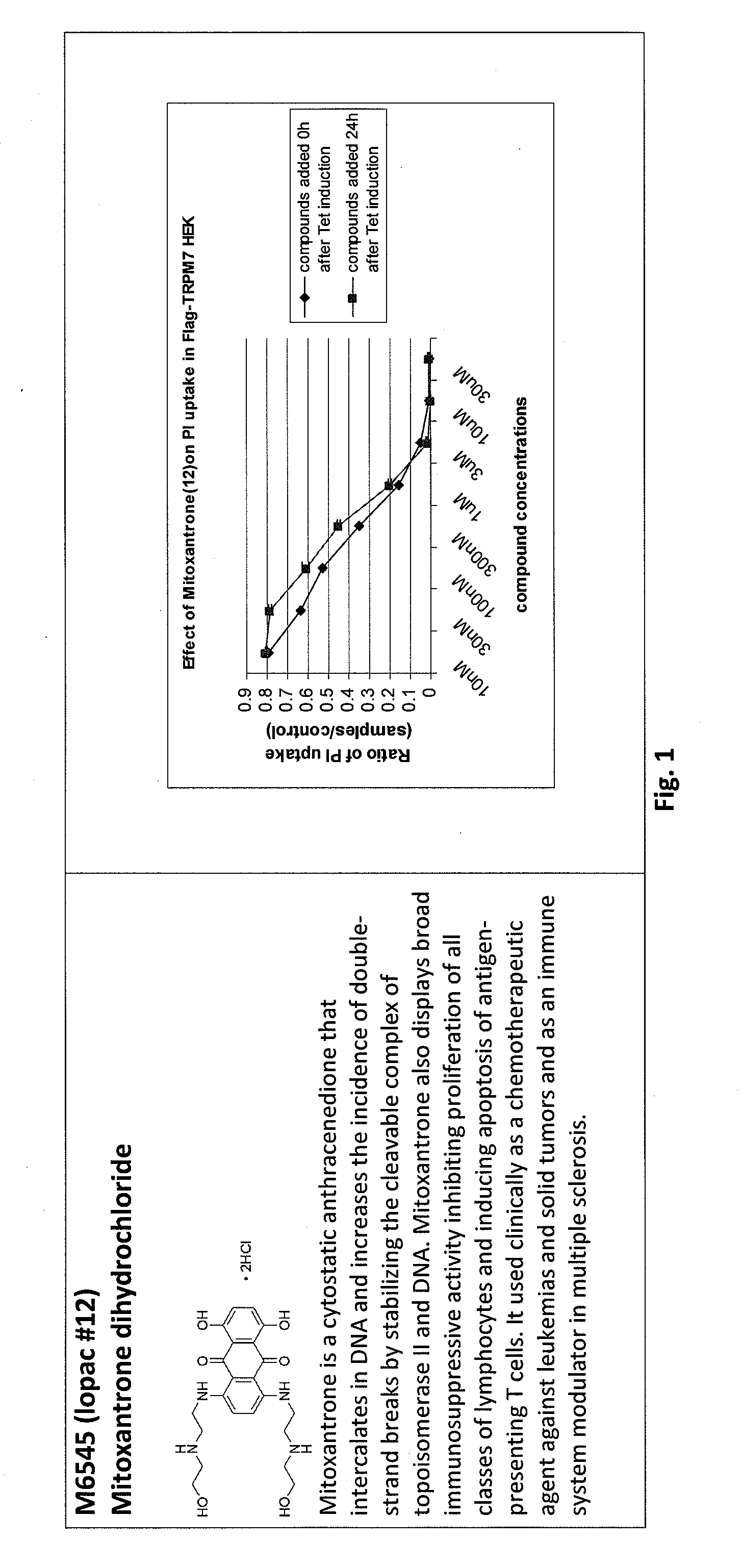Agents and methods for treating ischemic and other diseases
a technology of applied in the field of agents and methods for treating ischemic and other diseases, can solve the problems of affecting the treatment effect of patients, affecting the treatment effect, and causing neuronal death and neurological disability, so as to reduce or inhibit the damaging effect of ischemia, reduce or inhibit the damage of glaucoma, and reduce or inhibit the symptom of pain
- Summary
- Abstract
- Description
- Claims
- Application Information
AI Technical Summary
Benefits of technology
Problems solved by technology
Method used
Image
Examples
example 1
[0354]Assay for Screening for a Bioactive Agent that Modulates TRPM7 Activity
[0355]Introduction
[0356]An assay for screening for a bioactive agent that modulates TRPM7 activity can be created in which TRPM7 activity is evoked in cells, and then a bioactive agent that inhibits TRPM7 activity is tested to determine whether or not it prevents cell death in the assay. The cell may be expressing native (wild-type) TRPM7, or a recombinant TRPM7 which is transfected into the cell. In the present example, human embryonic kidney (HEK293 Trex) cells were stably transfected with a tetracycline inducible Flag-tagged TRPM7 construct.
[0357]To activate TRPM7 channels, TRPM7 ion channel activity may be increased by lowering extracellular divalent cation concentrations, especially Ca2+ and Mg2+ (Wei et al., 2007). This causes a marked increase in the ionic current carried by TRPM7 channels (FIG. 17 A-G). Tet-induced TRPM7-expressing HEK293 cells that are exposed to a reduction in divalent undergo spo...
example 2
[0398]TRPM7 and Anoxic Cell Death in H9c2 Cardiac Myocites
[0399]Introduction
[0400]As a model of cardiac ischemia and reperfusion, a rat ventricular myoblast cell line H9c2 is used (Kimes and Brandt, 1976). H9c2 cells are morphologically similar to embryonic cardiocytes and possess several characteristics of the electrical and hormonal signal pathways found in adult cardiac cells (Hescheler et al., 1991). This cell line has previously been used in cardiac research (Levrand et al., 2006; Zordoky and El-Kadi, 2007), and more importantly, in culture models of myocyte ischemia and reperfusion (Sakamoto et al., 1998; Ekhterae et al., 1999; Bonavita et al., 2003; Fiorillo et al., 2006; Coaxum et al., 2007).
[0401]Materials and Methods
[0402]Cell Culture
[0403]The rat cardiomyoblast cell line H9c2 was obtained from the American Type Culture Collection (CRL-1446) and cultured in Dulbecco's Modified Eagle Medium supplemented with 10% (v / v) heat-inactivated fetal bovine serum and 1% antibiotic-an...
example 3
[0416]An assay for detecting TRPM7-mediated Cellular Ion Flux and Cell Death mediated by Chemical Anoxia with NaCN.
[0417]Introduction
[0418]The TRPM7 channel provides a pathway for mono- and divalent cations into the cell, and is unique in that it contains a functional C-terminal α-kinase domain. Among the procedures known to activate TRPM7 channels, the TRPM7 channel has been shown to be activated by chemical anoxia using NaCN (Aarts et al., 2003). The induction of chemical anoxia in host cells such as recombinant HEK293 cells can be used to activate TRPM7. This activation is detectable with the use measurements of cellular calcium accumulation. This is achievable with the use of a fluorescent calcium indicator. Alternatively, this activation can also be measured using radiolabelled Ca2+ (45Ca2+) as described previously by Sattler et al. (Sattler et al., 1998) and Aarts et al. (Aarts et al., 2003).
[0419]Methods
[0420]Design of Specific TRPM7 Constructs
[0421]Flag-TRPM7 / pBluescript II ...
PUM
| Property | Measurement | Unit |
|---|---|---|
| nonphysiological voltages | aaaaa | aaaaa |
| nonphysiological voltages | aaaaa | aaaaa |
| time | aaaaa | aaaaa |
Abstract
Description
Claims
Application Information
 Login to View More
Login to View More - R&D
- Intellectual Property
- Life Sciences
- Materials
- Tech Scout
- Unparalleled Data Quality
- Higher Quality Content
- 60% Fewer Hallucinations
Browse by: Latest US Patents, China's latest patents, Technical Efficacy Thesaurus, Application Domain, Technology Topic, Popular Technical Reports.
© 2025 PatSnap. All rights reserved.Legal|Privacy policy|Modern Slavery Act Transparency Statement|Sitemap|About US| Contact US: help@patsnap.com



